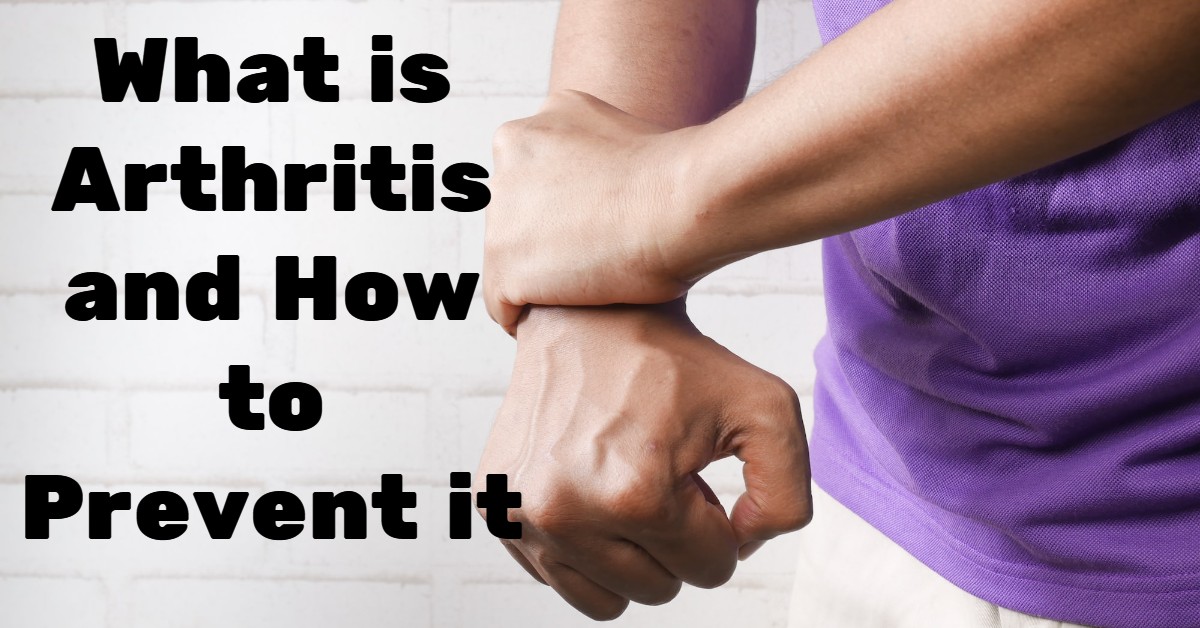What is Arthritis and How to Prevent it( A Good Guide)

What is Arthritis and How to Prevent it: Arthritis is a common condition that affects millions of people worldwide. It is a term used to describe a group of conditions that cause inflammation and pain in the joints. Arthritis can occur in people of all ages, but it is most commonly seen in older adults. EnoughInfo.com

While there is no known cure for arthritis, there are steps you can take to prevent it or reduce its impact on your life. In this article, we will explore what arthritis is, its different types, and some effective ways to prevent it. By understanding how to prevent arthritis, you can take control of your health and enjoy a better quality of life.
FAQs & Answers on What is Arthritis and How to Prevent it
Do certain types of weather make arthritis worse?
Certain weather might make arthritis worse. Cold and humidity cause joint discomfort. There are several causes. Winter and wet seasons reduce activity. Cold and dampness tighten joints and worsen arthritis. Other hypotheses claim that barometric pressure, or air pressure, may affect arthritis. Talk to your doctor if particular weather worsens your arthritis. Heat treatment, indoor exercise, and dressing warmly may assist in easing discomfort.
Can arthritis be cured or prevented?
Arthritis has no known treatment. The aim of therapy is to reduce pain and inflammation while maintaining joint function. Aside from medications, weight loss, exercise, and surgery are all available as treatments.
How long does it take for arthritis to heal?
Most post-traumatic arthritis cases last for a short time, often a few months. As your body recovers from the trauma, your symptoms can fade away. You may have persistent post-traumatic arthritis, which can last the remainder of your life if you encounter post-traumatic arthritis symptoms for more than six months.
What is Arthritis?
Arthritis is a condition that causes inflammation and pain in the joints. It is a term used to describe a group of more than 100 different conditions that affect the joints, bones, and muscles. Arthritis can occur in people of all ages and can cause significant pain and disability.
The most common symptoms of arthritis include joint pain, stiffness, swelling, and limited range of motion. There is no known cure for arthritis, but there are treatments available that can help manage symptoms and improve quality of life. It is important to work with a healthcare professional to develop an effective treatment plan if you have arthritis
The following body parts have the highest rates of arthritis:
- Feet.
- Hands.
- Hips.
- Knees.
- Lowered back.
What are the parts of a joint?
Soft tissues support and cushion joints, preventing your bones from rubbing against one another. A crucial component is a connective tissue known as articular cartilage. Your joints may move pain-free and without friction with its assistance. A synovial membrane, a cushioned fluid pocket that lubricates the joints, is present in some joints. Tendons and ligaments provide support for a number of joints, including your knees. While ligaments link bones to other bones, tendons link muscles to your bones.
What are the different types of arthritis?
- Osteoarthritis (OA): This is the most common type of arthritis, which occurs due to the wear and tear of the cartilage in the joints. It usually affects the hips, knees, hands, and spine.
- Rheumatoid arthritis (RA): This is an autoimmune disorder in which the body’s immune system attacks the joints, causing inflammation and damage. It usually affects the hands, feet, and wrists and can also cause fatigue, fever, and weight loss.
- Psoriatic arthritis (PsA): This type of arthritis occurs in people who have psoriasis, a skin condition that causes red, scaly patches on the skin. It can affect any joint in the body and may cause swelling and stiffness.
- Gout: This is a type of arthritis that occurs when uric acid crystals build up in the joints, causing sudden and severe pain, swelling, and redness.
- Ankylosing spondylitis (AS): This is a type of arthritis that mainly affects the spine, causing inflammation and stiffness that can lead to a hunched posture.
- Juvenile idiopathic arthritis (JIA): This is a type of arthritis that occurs in children under the age of 16 and can cause joint pain, swelling, and stiffness.
- Reactive arthritis: This is a type of arthritis that occurs after an infection, usually in the urinary or gastrointestinal tract. It can cause joint pain, swelling, and inflammation, as well as other symptoms such as fever and fatigue.
Each type of arthritis has its own specific symptoms, causes, and treatment options, so it’s important to work with a healthcare professional to develop an effective treatment plan.
Symptoms and Causes
Causes
There are several causes of different forms of arthritis. For instance, having too much uric acid in your body might cause gout. However, the precise aetiology of various forms of arthritis is not understood. It’s possible to get arthritis if you:
- Have a history of arthritis in your family?
- Have a career or sport that subjects your joints to repetitive stress.
- Have specific viral infections or autoimmune disorders.
There are several risk factors that can increase the likelihood of developing arthritis. Some of these risk factors include: How STDs Affect The Reproductive System
- Age: The risk of developing arthritis increases with age, especially after the age of 65.
- Gender: Women are more likely than men to develop certain types of arthritis, such as rheumatoid arthritis.
- Genetics: Certain types of arthritis have a genetic component, meaning that they run in families.
- Obesity: Being overweight or obese puts extra stress on the joints, which can increase the risk of developing arthritis.
- Joint injuries: Injuries to the joints, such as those from sports or accidents, can increase the risk of developing arthritis later in life.
- Infections: Certain infections can lead to the development of reactive arthritis.
- Occupation: Jobs that require repetitive motions or involve heavy lifting can increase the risk of developing osteoarthritis.
- Smoking: Smoking can increase the risk of developing rheumatoid arthritis and can also worsen symptoms of existing arthritis.
While these risk factors may increase the likelihood of developing arthritis, it is possible to reduce the risk by making healthy lifestyle choices, such as maintaining a healthy weight, exercising regularly, and avoiding smoking.
Symptoms
Different arthritis kinds cause various symptoms. They can vary greatly in severity between individuals. Joint soreness may be intermittent or persistent. Typical signs include:
- Pain and redness.
- Stiffness.
- Swelling.
- Tenderness.
- Warmth.
How arthritis is treated
Although there is no known therapy for arthritis, there are methods you may do to control your symptoms. The severity of the arthritis, its symptoms, and your general health will all affect your therapy options.
Among the conservative (nonsurgical) remedies are:
Medication
Painkillers and anti-inflammatory drugs may assist with arthritic symptoms. Biologic drugs work to reduce inflammation caused by your immune system. Your rheumatoid or psoriatic arthritis may be treated with biologics, according to a healthcare professional.
Physical therapy
Rehabilitation can assist in increasing mobility, strength, and range of motion. You can learn from therapists how to modify your regular routines to reduce arthritis discomfort.
Therapeutic injections
Cortisone shots may provide temporary relief from joint pain and inflammation. Viscosupplementation is a therapy that may help with arthritis in some joints, like your knee. It injects lubrication to facilitate easy joint movement.
How to Prevent Arthritis
Maintain a healthy weight
Excess weight can put pressure on your joints, particularly your knees, hips, and spine, which can increase your risk of developing arthritis. By maintaining a healthy weight, you can reduce the risk of developing arthritis or delay its onset. To maintain a healthy weight, try to eat a healthy diet rich in fruits, vegetables, whole grains, lean protein, and healthy fats. Limit your intake of processed foods, sugary drinks, and alcohol. Aim to engage in regular physical activity such as walking, swimming, or cycling for at least 30 minutes most days of the week.
Exercise regularly
Exercise can help strengthen the muscles around your joints, improve flexibility, and reduce the risk of developing arthritis. Low-impact exercises such as swimming, cycling, and yoga can be particularly beneficial for your joints. However, any form of exercise that you enjoy and can do regularly can be helpful. Aim to engage in regular exercise for at least 30 minutes most days of the week.
Protect your joints
Joint injuries can increase the risk of developing arthritis. To protect your joints, avoid repetitive motions that can strain your joints. Use proper form when lifting heavy objects, and use ergonomic tools at work to reduce the strain on your joints. If you play sports, wear protective gear to reduce the risk of joint injury.
Eat a healthy diet
A healthy diet can help reduce inflammation in the body, which can help reduce the risk of developing arthritis. Foods that are high in antioxidants and omega-3 fatty acids, such as fruits, vegetables, nuts, and fatty fish, can help reduce inflammation in the body. On the other hand, a diet that is high in processed foods, refined sugars, and saturated fats can increase inflammation in the body and increase the risk of developing arthritis.
Get enough rest
Getting enough sleep and rest is crucial to preventing arthritis. Adequate sleep and rest can help reduce stress and inflammation in the body, which can help reduce the risk of developing arthritis. Aim for seven to eight hours of sleep each night and take breaks throughout the day if you have a job that requires a lot of sitting or standing.
Don’t smoke
Smoking has been linked to an increased risk of developing rheumatoid arthritis. Quitting smoking can help reduce your risk of developing arthritis and a host of other health problems.
Manage stress
Stress can increase inflammation in the body, which can increase the risk of developing arthritis. To manage stress, try relaxation techniques such as deep breathing, meditation, or yoga. Engaging in regular physical activity, spending time with loved ones, and pursuing hobbies or interests can also help reduce stress levels.
See your doctor regularly
Regular check-ups can help identify and treat conditions that could increase the risk of developing arthritis, such as obesity or diabetes. Your doctor can also recommend lifestyle changes and treatments that can help reduce your risk of developing arthritis or manage the symptoms if you already have it. How to Prevent Osteoporosis from Getting Worse
What you can do to make Living with Arthritis Easier
Living with arthritis can be challenging, but there are several things you can do to make it easier. One of the most important things you can do is to stay physically active. Regular exercise can help reduce pain, increase flexibility, and strengthen the muscles around your joints. You can also try incorporating assistive devices, such as canes or braces, to help reduce stress on your joints. Additionally, taking breaks throughout the day and practicing stress-reducing techniques, such as deep breathing or meditation, can help reduce pain and inflammation. Lastly, don’t be afraid to ask for help from friends, family, or healthcare providers when you need it. By taking these steps, you can make living with arthritis more manageable and improve your quality of life.
Conclusion
Arthritis is a common condition that affects millions of people worldwide. What is Arthritis and How to Prevent it? We have given you all the details.
By taking steps to prevent arthritis, you are not only protecting your joints but also investing in your overall health and well-being.
Incorporating healthy habits into your daily routine can be a fun and creative process, from exploring new healthy recipes to trying out new exercise routines.
By making these lifestyle changes, you can not only reduce the risk of developing arthritis but also enhance your quality of life, promote longevity, and enjoy the benefits of a healthy body and mind. So why not take a step towards a healthier future today?
Recommended:
How Does Rheumatoid Arthritis Affect The Heart And Lungs?
How to Prevent Osteoporosis from Getting Worse
22 Top Foods For Promoting Heart Health(All You Need to Know)




